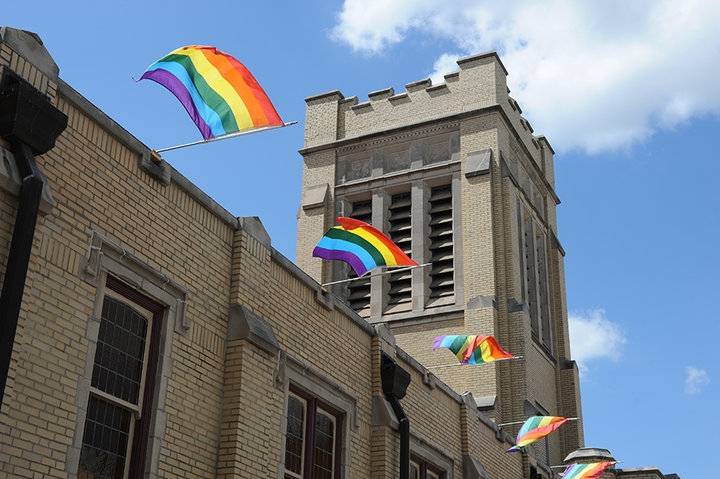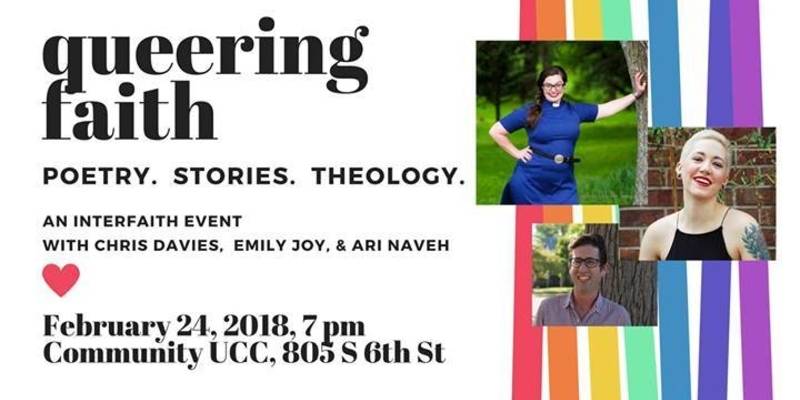The word “queer” and “faith” are often placed at odds with each other. Faith communities have generally not been welcoming and inclusive of those who do not identify as heterosexual and cisgender, and often damaging to those not falling within those boundaries. Reverend Leah Robberts-Mosser, of Community United Church of Christ, captured this in a story about a young family member coming out to her. His first concern was not what his parents would think, but instead what God would think. “This is a kid who’d gone to church every single Sunday of his life,” Robberts-Mosser said, “sat in Sunday School, sung Jesus Loves Me, and he didn’t know that this was true, even in the light of this reality.” Queering Faith, happening this Saturday, February 24th at 7 p.m. at CUCC, is one step toward bringing the words “queer” and “faith” and the ideas surrounding them, into common space and beyond the typical binary that exists.
The event, which is co-sponsored by the UCC Campus Ministry of UIUC, Illini Hillel Foundation, the UP Center, and the University YMCA, features Reverend Chris Davies, who is on the national staff for the UCC church, Rabbi Ari Naveh of Illini Hillel, and Emily Joy, a spoken word artist who performs and speaks all over the country on faith issues. I spoke with Robberts-Mosser and Naveh about the event and how their faith communities consider the idea of “queering faith.”
Smile Politely: So how did the idea for this conference come about.
Leah Robberts-Mosser: We stumbled upon the Carpenter Foundation, which is a granting agency that values lots of different things. One of the things they value is the intersection between LGBTQ+ issues and young adults and faith. We fit right in the center of that intersection. We were awarded a $5000 grant. I’m friends with Reverend Dr. Chris Davies, who’s on the national staff of the UCC, and one of her passions is “queering proclamation.” So getting beyond the binary of queer vs. faith, and making pathways for people to embody that binary. We reached out to Chris and asked if she’d be willing to do an event. Then an interesting thing happened. We started talking with Chris, and she said I met this spoken word artist, Emily Joy. We reached out to her and she actually shifted her schedule to come to this. So what’s interesting is you have two queer women from very different faith backgrounds. Chris being a cradle to grave UCC person, faith vs. queerness has never been part of her reality. But for Emily Joy, having been raised evangelical, having gone to Moody Bible Institute, she’s been living that tragic dichotomy her whole life. When we reached out the the UP Center to see if they wanted to partner with us, within the next week I had two different faith leaders call me and say they wanted to partner. One of those was Ari, the rabbi and head educator at Hillel.
SP: And how did Illini Hillel become involved with the event?
Ari Naveh: I’d heard about it peripherally through the UP Center, and a friend of mine who is on their board mentioned that it was happening…initially it was called “Queering Church.” It sounded like something that I thought would be really awesome. I actually met Leah, and I said look this is something I’d love to be a part of as a queer faith leader. These are two really important intersections in my world, and I’d love to see what we could do with that. So from there it molded to not just “queering the church” but “queering the faith” in general, and looking at those intersections from an interfaith lens.
SP: What does that term “queering faith” mean to you?
Robberts-Mosser: As the straight girl who’s the pastor of the church with the rainbow flags, I have to be really careful with how I use that word, because it’s not my word. That’s a contentious word. Generationally, there are differences of opinion on what that word means, because historically it has been and still is a very derogatory and hate-filled word. And at the same time, people younger than me, who self identify as LGBTQ+, have reclaimed that word and owned it and transformed it into something that is powerful. It has to do with a completely different worldview. It’s not just gender identification, but about how we live and move in the world. Like whenever I sit down to plan worship, I “queer” the liturgy. It looks like getting beyond the western influence that shows up in liturgy that shows up in binaries, and thinking differently about the world.
Naveh: I think it’s challenging, because I think it means that faith leaders have an opportunity, actually an imperative to demonstrate what radical love, radical acceptance can look like within their communities. Understanding how queer people fit into faith communities, because faith communities have a lot of baggage in contending with queer folk. The onus is on them to demonstrate how they are unpacking that. That’s a lot of what this event will be. The onus is not on queer folk to make themselves a part of the community, the onus is on the community to say “we welcome you, we want you here, we want to engage with those difficult texts that have been used as a weapon against you for so long.” I think that’s why it’s so exciting for me to be a part of this, because I know personally how those texts have been used against me.

SP: How has your faith community challenged the idea of that queer vs. faith binary and reached out to the LGBTQ+ community?
Robberts-Mosser: This congregation has been publicly open to and affirming of LGBTQ+ people since 1995. They went through a discernment process then made a public declaration and private covenant that they would keep and hold safe space for people, and they would make this church a place that is embracing and empowering and life giving instead of shaming and damning. When I showed up as pastor, there was no visible indicator, walking past the church, that would tell someone who was LGBTQ+ that this was a safe space. That doesn’t work. Because people have used faith historically to justify abuse. If you’re going to be open and affirming, you have to do it publically and loudly. People are wounded, and they have to know this is a safe space. So the buildings chair and I one Saturday, and I didn’t ask anybody if I could do this, we just hung up 12 rainbow flags on the building. I have to be an ally, and I have to be a relentless ally. Because those rainbow flags literally save people’s lives, I know that’s true.
Naveh: We’re getting there. I think we have a bit of a ways to go. I think just by making sure that we are building bridges on campus. We’ve developed a great relationship with the LGBT Resource Center on campus, with the UP Center in the community, in fact next Thursday we’re hosting a drag show for Purim. That’s a great demonstration of queering our faith. The story of Purim is a particularly not just satirical but queer story. There are certain elements that really fit into the idea and ideals of drag. It’s a fun way to look at the tradition, and welcome as many different voices in our community as we can. We’re also hosting a seder during Passover that will feature a lot of queer elements as well.
If you attend Queering Faith, you can expect an experience that is a “combination of art, storytelling, poetry, and theologizing.” Attendees will be presented with deep questions for reflection, scripture verses for drawing inspiration, and open discussion of what it means to exist in a “queer” body, and celebrate it as a being made in the image of God. The event is open to all, no matter what your faith background (or lack of one) and no matter how you identify.
The event is free, but you can register and find out more about the speakers here. Also, check out this spoken word video by Emily Joy.








